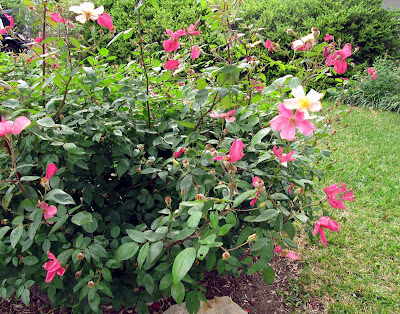 'Belinda's Dream' was already an overblown beauty when our son & his dear wife arrived; 'Julia Child' still had buds and the Mutabilis rose was in full glory. But too many days with heat & dry winds made most flowers open too quickly and fall apart even faster.
'Belinda's Dream' was already an overblown beauty when our son & his dear wife arrived; 'Julia Child' still had buds and the Mutabilis rose was in full glory. But too many days with heat & dry winds made most flowers open too quickly and fall apart even faster.Today I noticed that 'Julia Child' looks much better when seen from across the garden, veiled by larkspur. Would that work for falling-apart garden bloggers, too?

The timing was absolutely perfect for the Confederate-Star jasmine/Trachelospermum jasminoides... one plant grows near the steps of the veranda near the drive. Its fragrance is not something you can ignore so luckily our daughter-in-law liked the scent!

The fragrant yellow double Oleander didn't open its first flower until after the guests drove away

The usual show of spring wildflowers along the highways has been muted somewhat by drought. Irrigating all the roadsides in Texas can't be done, but it doesn't take much water to keep a little patch happy in the garden and deadheading extends the season. Here are Blackfoot Daisies, Purple & White Annual Phlox, Texas Paintbrush & Bluebonnets, with the orchid-purple Salvia greggii in the bottom right corner. Those strappy leaves at lower left belong to the native white rainlilies - they've bloomed on and off all week but not on the 15th!

Here's the view from the other side of the bed - Bluebonnets and Paintbrush with the orchid-purple Salvia greggii at left. The salvia and rainlilies are perennials. The Bluebonnets are annuals - this time from seed given to me by MSS of Zanthan Gardens. The Paintbrushes can be perennial. These have been around a couple of years.

My best guess on the name of the white rainlilies is Zephyranthes drummondii - or perhaps Cooperia drummondii or even Cooperia pedunculata. They grew on the hill behind our first Austin house but to see them bloom, I had to dig up a few bulbs and grow them in deck containers where the deer couldn't get them. I brought them along when we moved here so the white rainlilies now grow in garden beds. This one in the Pink garden was open for GBBD.
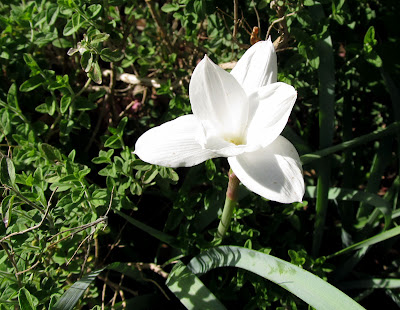
Another wildflower was timed perfectly for the visitors: Herbertia, a tiny iris relative that appears in April. Its proper name seems to be Herbertia lahue. The first plant surprised us when it popped up in the grass in 2005. A few flowers reappear each April but the numbers haven't increased. This is a native Texas plant, but it may have hitched a ride to my yard. Herbertia is reported to grow in large swaths near Houston and I've been told that when our subdivision was built in the 1970's, some of the fill soil came from East Texas. Some wildflower books call it Prairie Nymph - other books say that name belongs to a different flower. Under any name it's worth getting down to ground level for a closer look.

The gauras and salvias in the front beds are budded but not in bloom so let's go around the far side of the house where another Confederate AKA Star Jasmine blooms in the Secret Garden. (The name 'Confederate' is interesting - some references say the plant originated in Asia and the name dates from the 1890's when part of Malasia was the Federated or Confederated Malay States. But with that unsettling hint of Civil War in the name, I sometimes opt for the more neutral 'Star Jasmine'. )
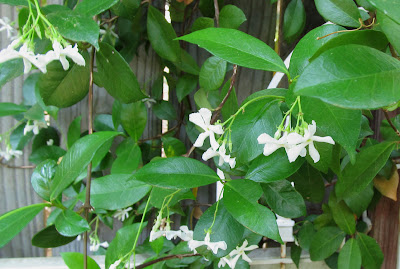
A few feet away, the pomegranate tree has a scattering of flowers and buds. This tree was labeled as variety 'Wonderful' but it's never made a single pomegranate fruit. Look how doubled and ruffled the flower is on my tree:

Last weekend we took our family to Mayfield Park and the pomegranates were in bloom there. I took a photo of the Mayfield variety and noticed that the flowers are simpler and not as congested. This makes me wonder if our pomegranate's blooms are too fluffy for successful pollination.
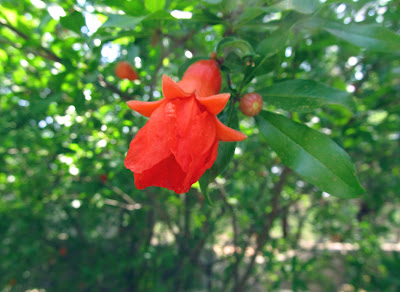
There's a delicate pink flower not far from the pomegranate in the secret garden - an Indigofera/Pink False Indigo. This plant has a reputation for being a spreader, but in 5 seasons here it's behaved well, tucked in with native ferns and Cast Iron Plant:
 Also in the Secret Garden is the Blue Sky vine from the March GBBD post. The plant was already budded and in bloom when I bought it but now it's down to the last blossom. The vine itself is growing like mad and has reached the top of the arch - maybe there will be more flowers on the new growth?
Also in the Secret Garden is the Blue Sky vine from the March GBBD post. The plant was already budded and in bloom when I bought it but now it's down to the last blossom. The vine itself is growing like mad and has reached the top of the arch - maybe there will be more flowers on the new growth?
Through the arch and over to the bed where a bright coral, unlabeled mini-rose planted by some previous owner is in bloom. We've added bulbs like Iphieon/Star Flower, Oxalis and Hippeastrum, the familiar holiday Amaryllis, which can survive outside in Austin.

Also in the bed are other flowers with flowers in the orange/coral range - a few plants of Mountain sage/Salvia regla that will bloom in fall and this native columbine:
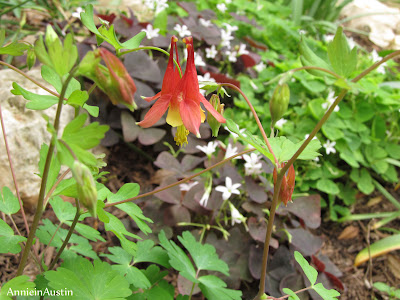
We made a small bed for a 'Pride of Houston' yaupon under the canopy of the back pecan in 2009. That small bed turned into a new long border in early 2010 and most of the young plants are doing well. Cedar sage/Salvia roemeriana grows at the high end of the bed near the original yaupon and it looks pretty happy.

Then last week we all went to McKinney Falls state park and for the first time I saw Cedar Sage in its natural environment of hill & rocks in an oak forest. Now my Cedar Sage is demanding a dramatic stone backdrop, too.

The Oakleaf Hydrangea has produced five large flowerheads. Behind the Hydrangea is Ageratina havanensis, a native fragrant white mist flower, and it's making buds! I'm not sure what's going on -we have two more of these mistflowers in front but they've never bloomed in spring - just in fall.

The front edge of this long bed is in sun - here are Four-nerve daisies, Bluebonnets, Creeping phlox, larkspur, Louisiana iris and Siberian iris

In the background below you can make out a white 'Climbing Iceberg' rose and the original plant of a passalong Siberian iris. A small piece of the iris came from Chicago back in 2005. The small piece took years to become a clump and was finally large enough to divide last year when we made the new bed. Siberian iris sometimes take a while to settle in, so it was a pleasant surprise to get flowers on the new division this spring!
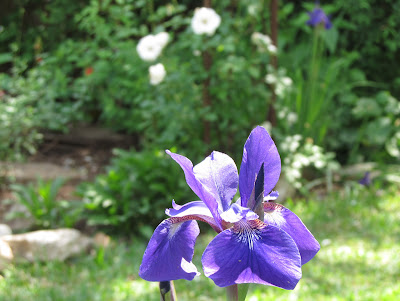
Near the birdbath fountain the 1-year old 'Red Cascade' climbing miniature rose is in bloom, its pure red color looking good against the Lueders stone.

The clematis known as 'Starts-out-ruby-red-then-fades-to-reddish-purple' is in full bloom now - a good surprise. The tangle of vines had become so buggy and moldy that in late winter I cut it down almost to the ground, carefully removing every leaf and washing the trellis. The plant sent out new shoots to cover the trellis by the end of March and the first flower opened the day our family arrived.

Late on Friday afternoon one flower on the 'Little Gem' magnolia swelled to open... but so high up that the zoom couldn't get a good view
 And finally, here is my contribution to the Odd Poppy posts from Austin Garden Bloggers (Robin Getting Grounded, Rock Rose Jenny, MSS of Zanthan Gardens) who all experienced unexpected results when they grew Frilly Pink Poppies from seed. Scattering poppy seed hasn't worked for me, so I bought a few started plants from the Natural Gardener on March 6th. The only color I could find was labeled 'Maroon'. A few days ago they looked like this:
And finally, here is my contribution to the Odd Poppy posts from Austin Garden Bloggers (Robin Getting Grounded, Rock Rose Jenny, MSS of Zanthan Gardens) who all experienced unexpected results when they grew Frilly Pink Poppies from seed. Scattering poppy seed hasn't worked for me, so I bought a few started plants from the Natural Gardener on March 6th. The only color I could find was labeled 'Maroon'. A few days ago they looked like this: 
But soon after the other bloggers mentioned frilly pink poppies one appeared in my garden... maybe a stray seed in with the maroon plant?
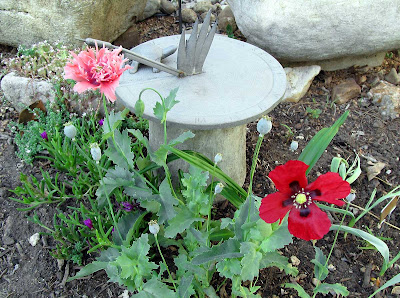 This one's a bit salmon-pink but it should be good enough to get me in the Frilly Pink Poppy club!
This one's a bit salmon-pink but it should be good enough to get me in the Frilly Pink Poppy club!
As you can see we're long past tulip & daffodil season here in Texas - to see those traditional spring favorites and to check out what's blooming all over the world go to Carol's round up over at May Dreams Gardens. , the Garden Blogger Bloom Day headquarters.
For more about Mayfield Park, see
For the complete April list of blooms with my best guess at botanical names, please go to Annie's Addendum.
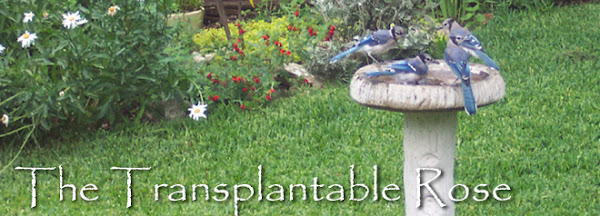








That's a heck of a recovery for the clematis - very nice looking. And a rain lily bloom - none of mine have even hinted at that (I can't imagine why...oh, that's right - the whole rain thing).
ReplyDeleteThanks for the Mayfield Park link love, Annie! Your clematis is gorgeous. You'll be pleased to hear that all the cemetery iris you passed along to me are actually In The Ground, with my fingers crossed for blooms next year!
ReplyDeleteWow, Annie! Seems I almost always begin my comments to you with "Wow!", but you have so many showy blooms. One would never know we're in a drought by looking at your photos. I finally have my first larkspur but haven't yet joined the poppy club. Maybe this fall? Trying to figure out how to knit myself a larkspur veil.
ReplyDeleteThat frilly pink poppy is a lovely surprise. My poppy patch was accidentally mowed by my neighbors before it bloomed, which is the other sort of surprise. Your double oleander is a beautiful buttery shade, and I love that clematis!
ReplyDeleteWow, you certainly have loads of blooms! That skyflower and those clematis are my favourites. I never knew there was a yellow double Oleander-will have to look out for that. I guess I have the single one.
ReplyDeleteHey Annie, I also have all those roses, but did you hear what happened to mine? Winter was abysmal and tried to kill every rose I have. Most died down to 18 inches. It's gonna be a long year for them to come back I think. Thanks for the links to the poppy posts. I'll pop on over.
ReplyDeleteI smelled Confederate jasmine the other day and thought how wonderful it was. Yours is lovely. Oh, and I think anything or anyone can be improved by Larkspur. :) ~~Dee
Wow, I know that you envy my lilac buds, but I think I envy that you have SO MANY things in your garden worth posting about. I can imagine how wonderful that jasmine must smell!
ReplyDeleteAnnie, I love that you included Herbertia. I love the blooms of that plant and I look forward to them each spring. I wish I DID have large swaths of them but there are only a few scattered here and there out front.
ReplyDeleteI like that little iris-cousin flower. And I always figured (in all of the 5 years I've known about the plant) that it was called Confederate Star Jasmine because it only grew in the southern US.
ReplyDeleteHello RBell- you never know what will happen in a kill-or-cure situation -the clematis was lucky! Were your white rainlilies there naturally? I don't see them around my neighborhood.
ReplyDeleteIt was a wonderful post Caroline - you'd think I could get your name right, especially since it was on the short list for one of our kids - but it's not a good name for a boy!
Hi Iris - the larkspur plants itself now - wonder if we can get poppies to reseed after a few years?
Hello Amy - sorry about your poppy field. The oleander came as a rooted cutting from Plant Delights Nursery more than 10 years ago - described as especially hardy for cold. It's been in a series of ever-larger containers rather than in the ground.
I'd seen the Skyflower on a garden tour Nicole, so when it was on sale for $5, I had to get it!
Annie
What a shame about the roses, Dee of Red Dirt - that's not normal Oklahoma weather! In IL the David Austin roses sometimes died down to a couple of inches but they usually got up to a couple of feet & bloomed anyway. Hope yours bounce back!
ReplyDeleteThe thing about lilacs, Tigerlily, is that they've been loved by people, grown & crossed for hundreds of years, resulting in many different varieties, colors, heights, bloomtimes, doubles, singles and even some difference in scent. They have personality & mystery. Few of the shrubs that grow here are that interesting! You just see the same stuff everywhere.
I really like the delicacy & color of the Herbertia, Cindy from Katy, - how cool that you're a fan, too!
I'll bet most people think the jasmine is named for the Confederate States of the South, Katina - read about it a few years ago and was surprised, too. Also was surprised at how closely related it is to the despised Asiatic jasmine the invasive groundcover. Guess I'd better keep an eye on it!
Thanks for the comments,
Annie
My gosh Annie, so much is abloom in your garden. I love the little hitchhiker in the grass. Lucky you. I didn't know there was a minature rose climber. I just love minature roses but I don't have one in my garden. I wonder if it would live in my zone6? Happy GBBD.
ReplyDeleteWhat a magnificent display for your family to enjoy, Annie! I didn't realize pomegranate trees flowered like this--the blooms are so pretty it almost makes you forget about not having any fruit. Also love that little stray ruffled poppy; I've never had any luck scattering poppy seeds either.
ReplyDeletei'm glad some of your plants obeyed your wishes.
ReplyDeleteAnnie, I too thought I had 'Wonderful' pomegranates, but when they didn't fruit I began to wonder. I'm thinking they might be 'Flore Peno' or flowering pomegranates. I don't mind at all though as they are the longest bloomers that I have.
ReplyDeleteWow. So lovely. Up here our gardens still wear daffodils and hyacinths.
ReplyDeleteI have no idea why it has taken my so long to stumble upon your blog, but I finally did :) I just had company and my roses did the same thing, past their peak right before they came. But from the looks of your garden, it wouldn't matter in the least. Beautiful!
ReplyDeleteI didn't know that there was a mini climbing rose. What zone?
ReplyDeleteYou have so many things blooming now...we are just starting to show blooms here in No. Illinois.
Balisha
Annie, as always, your yard is lush and gorgeous. That clematis is stunning and what a recovery it made. And I didn't know that there were double flowering Oleaders; that's quite stunning. I love your mix of roses and wildflowers. By the way, I've photographed your Irises now on my blog! Thanks again.
ReplyDeleteLisa at Greenbow and Balisha in Northern IL - the zone for Red Cascade is 5B - so probably no problem for you, Lisa, but it might die back for Balisha. It grows pretty fast, so maybe just a deep mulch to keep the roots alive would work.
ReplyDeleteHi Prairie Rose - I think our first sight of pomegranate flowers was at Zilker Botanical gardens not too long after we moved to Texas. One look was enough to covet the flowers!
My DIL loves roses, Vertie, so I did want them at their best. And I always want everyone to see & catch the scent of the Banana magnolia.
All I've had is a few pomegranate flowers each spring, Anonymous - no long flowering time. Thanks for the input! I have a dwarf 'Nana' that flowers off and on all year with a tiny fruit once in awhile, definitely grown as an ornamental.
Our son & his wife went back to daffodils wearing SNOW, Sissy - while ours opened and fried quickly. It sounds like winter won't leave you and we've already lost spring.
Hello Jess from Charleston, SC - once the heat hits many of the showier, prettier flowers will desert us - April is frequently the best month for blooms here. Your blog looks lovely! Have you ever been to Mrs Whaley's Garden in Charleston? That's one of my dreams.
Thank you so much, Robin Get Grounded - the iris post is wonderful. The clematis came with a wrong ID so it was a surprise to see how well it responded to chopping. It's less lush in real life than in the photos - the green grass is mainly around the birdbath, so I shoot low and across and crop the heck out of all the pictures.
Thanks for the comments! Did anyone click to expand the photos? They look better when enlarged.
Annie
Annie, so absolutely gorgeous, despite the winds and heat and drought. Your son and his wife still had to consider themselves in heaven. Now you've reminded me: I simply must have the indigofera. And the blue sky vine. Thanks for such inspiration with all your plants!
ReplyDelete